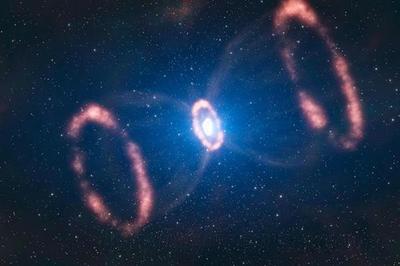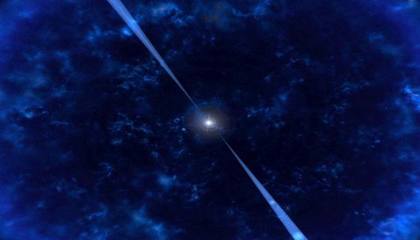【连载】万有引力常数变化的最终启发(二)
...and some more
...还有更多
Variations in G are not only present in Cavendish experiments andfree fall setups. They have been recorded by nature in severalways, which we can now interpret and use to find out theconstraints of the variation of the gravitational constant over along period of time. Astrophysical constraints on this variationhave been obtained using various observation methods includinglunar occultations and eclipses (Muller et al 1991), and planetaryand lunar radar-ranging measurements (Shapiro 1990),helioseismology (Guenther et al 1998), primordial nucleosynthesis(Olive et al 1990), gravitational lensing (Krauss &White 1992), and white dwarf luminosity function (Garcia et al1995). Determinations based on celestial mechanics provide theconstraints on the variation of G of (dG/dt)/Go ≤ 10E-12/year.Other methods, such as those utilizing neutron star masses(Thorsett 1996), globular cluster ages (Degl'Innocenti et al 1995),and binary pulsar timings (Damour & Gundlach 1991)and helioseismology (Demarque et al). 1994, have yielded similarconstraints on the long term averaged variation of thegravitational constant. Another way to determine the long termaverage change in G is by analysing the variation of planets'radii. The best limit comes from Mercury, which gave the limit onthe variability of G, (dG/dt)/G ≤ 8E-12/year, which comes from thefact that the radius of Mercury has changed at most one km duringthe last 3000 to 4000 million years.
G值的变化并不仅仅存在于Cavendish的实验和自由落体装置中。自然界已经用好几种我们现在已经能够了解的方式记录下了这种变化,而且我们可以据此寻找很久以来万有引力常数变化的约束条件。在天体物理学上对G值变化的约束条件已经通过不同的观测方法获得,这些方法包括月球的圆缺变化法(Mulleret al 1991),行星和月球探测雷达法(Shapiro 1990),helioseismology法 (Guenther etal 1998),原始核合成法(Olive et al 1990),重力透镜化(Krauss &White 1992),以及白矮星发光度函数法(Garcia et al1995)等。基于天体力学的测定证明了G值变化的约束为(dG/dt)/Go ≤10E-12/年。还有其他方法,像利用中子星质量法(Thorsett 1996),球状星团寿命法(Degl'Innocenti etal 1995), 二进制计时脉冲星法(Damour & Gundlach1991)以及日温计法(Demarque etal)等。另外一个测定G值长期平均变化量的方法是通过分析行星半径的变化。最好的结果来自对水星的观察,其得到的G值变化的限制范围是(dG/dt)/G≤ 8E-12/年,这个结果来自一个事实——即水星的半径在过去的30~40亿年间最多改变了1千米。
The collection of these new results suggests that the something iswrong or missing in our understanding of G. By the end of 1999, theinternational committee CODATA, decided to officially increase theuncertainty of the accepted value for the gravitational constantfrom 128 ppm to 1500 ppm. This remarkable step of increasing theuncertainty instead of decreasing was made to reflect thediscrepancies between the mentioned experiments. In my theory ofabsolute velocity of matter, I will show that the variation withinall these experimental results, not only IS NOT due to experimentalerror, but that the measure of the variation itself is of paramountimportance to our understanding of physical laws, and indeed of thewhole universe. Several physicists, among them Arthur Eddingtonand Paul Dirac, have speculated that at least some of the'fundamental constants' may change with time. In particular, Diracproposed that the universal gravitational constant, G, is relatedto the age of the universe T, with the relationGmp2/hc~T-1. Then as the agevaries, some constants or their combinations must vary as well.Atomic constants seemed to Dirac to be more stable, so he chose thevariation of G as 1/T, in other words, the gravitational forceweakening as the universe expands. In one of his lectures, RichardFeynman said "...the gravitation attraction relative to theelectrical repulsion of two electrons is 0.24E-42... the ratio oftime taken for light to travel across a proton to the age of theuniverse is 0.63E-42...this relation is not accidental (also knownas Dirac's large number hypothesis), in which case thegravitational constant would be changing with time, because as theuniverse got older, the ratio of the age of the universe to thetime which it takes for light to go across a proton would begradually increasing." A few modern generalised theories ofgravitation also admit or predict the variation of G with time.Revival of interest in the Brans-Dicke and alike theories, withvariable G, was in fact motivated by the appearance of superstringtheories where G is considered to be a dynamic quantity. Theacceptance of a non zero variation in G, would of course requirethe revision or extension of general relativity, since this oneassumes a constant G, which experimental evidence seems toconsistently deny. The acceptance of a variable G, will of courseset the dawn of a new physics.
这些新测得的数据似乎暗示某些地方搞错了,或者在我们理解G的过程中出现了偏差。在1999年底,国际委员会CODATA决定正式把万有引力常数G的误差范围由0.0128%提高到0.15%。制定这个不平常的措施就是用来反映上述实验中出项的种种差异。在我的物质绝对速度理论中,我会展示所有这些实验中的变化量,不仅不是实验的误差,而且这些数值变化所具有的重要性,除了体现在我们对物理定律的理解中,还体现在我们对整个宇宙的理解中。包括ArthurEddington和PaulDirac在内的几位物理学家已经推测过了‘基本常数’中的一些会随时间而改变。特别是Dirac曾提议,宇宙万有引力常数G跟宇宙的年龄T有关系,而且这个比例系数为Gmp2/hc~T-1。然后随者年龄的变化,一些常数或者它们的组合参数一定会随之改变。Dirac认为原子常数更为稳定,所有他选定了G的变化是T的倒数,也就是说,随者宇宙的膨胀,万有引力会变弱。RichardFeynman在他的一次演讲中说过“……相比较于两个电子间的排斥力,引力作用是0.24E-42...光线穿越质子的时间跟宇宙年龄的比值为0.63E-42... 这个关系并不意外(同样知名的还有Dirac的大数假设),在这种情况下,重力常数会随着时间的变化而变化,因为宇宙变得越来越来老,宇宙的年龄跟光线穿越质子所花时间的比值会逐渐增大。”万有引力的一些现代generalised理论同样承认或预言G值是随时间而变化的。Brans-Dicke以及相似的理论再次复兴,变化的G值,事实上是由超弦理论的出现而引起的,其中的G被认为是一个动态变量。G值是常数的观点似乎从实验中被不断地否定,接受G值不是恒定不变的这个事实,将自然而然要求修正或扩充原先认为G是常数的广义相对论。接受一个变化的G,无疑会导致出现新物理学的黎明。
(本资料共有八篇,只翻译了两篇,很不容易,谢谢传播并翻译这份资料的sywalt) 爱华网
爱华网



